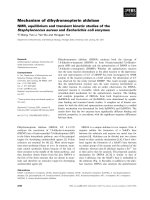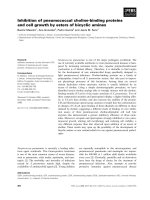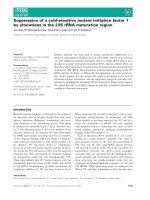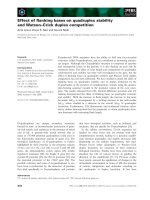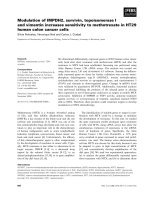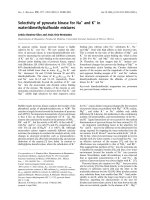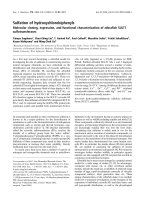Báo cáo khoa học: "ffect of induction agent on vasopressor and steroid use, and outcome in patients with septic shock" ppsx
Bạn đang xem bản rút gọn của tài liệu. Xem và tải ngay bản đầy đủ của tài liệu tại đây (239.67 KB, 8 trang )
Open Access
Available online />Page 1 of 8
(page number not for citation purposes)
Vol 11 No 3
Research
Effect of induction agent on vasopressor and steroid use, and
outcome in patients with septic shock
David Charles Ray and Dermot William McKeown
Department of Anaesthesia, Critical Care & Pain Medicine, Royal Infirmary of Edinburgh, Little France Crescent, Edinburgh EH16 4SA, Scotland, UK
Corresponding author: David Charles Ray,
Received: 22 Feb 2007 Revisions requested: 21 Mar 2007 Revisions received: 11 Apr 2007 Accepted: 16 May 2007 Published: 16 May 2007
Critical Care 2007, 11:R56 (doi:10.1186/cc5916)
This article is online at: />© 2007 Ray and McKeown; licensee BioMed Central Ltd.
This is an open access article distributed under the terms of the Creative Commons Attribution License ( />),
which permits unrestricted use, distribution, and reproduction in any medium, provided the original work is properly cited.
Abstract
Introduction In seriously ill patients, etomidate gives
cardiovascular stability at induction of anaesthesia, but there is
concern over possible adrenal suppression. Etomidate could
reduce steroid synthesis and increase the need for vasopressor
and steroid therapy. The outcome could be worse than in
patients given other induction agents.
Methods We reviewed 159 septic shock patients admitted to
our intensive care unit (ICU) over a 40-month period to study the
association between induction agent and clinical outcome,
including vasopressor, inotrope, and steroid therapy. From our
records, we retrieved induction agent use; vasopressor
administration at induction; vasopressor, inotrope, and steroid
administration in the ICU; and hospital outcome.
Results Hospital mortality was 65%. The numbers of patients
given an induction agent were 74, etomidate; 25, propofol; 26,
thiopental; 18, other agent; and 16, no agent. Vasopressor,
inotrope, or steroid administration and outcome were not related
to the induction agent chosen. Corticosteroid therapy given to
patients who received etomidate did not affect outcome.
Vasopressor therapy was required less frequently and in smaller
doses when etomidate was used to induce anaesthesia. We
found no evidence that either clinical outcome or therapy was
affected when etomidate was used. Etomidate caused less
cardiovascular depression than other induction agents in
patients with septic shock.
Conclusion Etomidate use for critically ill patients should
consider all of these issues and not simply the possibility of
adrenal suppression, which may not be important when steroid
supplements are used.
Introduction
In patients with sepsis, induction of anaesthesia can be haz-
ardous. Hypoxaemia, hypotension, volume depletion, and renal
impairment may be present. No currently available induction
agent is ideal. Possible agents are propofol, thiopental, etomi-
date, midazolam, and ketamine. In non-septic patients, cardio-
vascular depression is greatest with propofol [1,2], but
thiopental can also cause significant hypotension [1-3]. Etomi-
date causes less cardiovascular depression than propofol or
thiopental [1,2], but it can suppress adrenal function through
blockade of 11β-hydroxylase [4-7]. This suppression persists
for at least 24 hours [8,9], and some authors suggest that it
may last up to 72 hours [10]. This could harm patients with
critical illness such as severe sepsis or septic shock.
Etomidate has been scrutinised with regard to its safety in crit-
ically ill patients [11-16]. Much of this debate has been fuelled
by opinion rather than clear evidence of deleterious clinical
effect. Etomidate undoubtedly causes adrenal suppression,
but the clinical consequences of this are not clear. Adrenal
suppression in critical illness is controversial, particularly 'rela-
tive' adrenal insufficiency [17-19]. The incidence of adrenal
suppression in septic shock ranges from 9% to 67% [18,20-
22], but there is little evidence that adrenal suppression is
related to outcome [8,20,23,24]. Cortisol response to cortico-
trophin is more frequently impaired in critically ill patients given
etomidate [8,9], including those with septic shock [23], than
those who receive an alternative induction agent. Retrospec-
tive analyses suggest that etomidate may be associated with
increased mortality in septic patients [10,25]. Corticosteroid
treatment of these patients appeared to improve outcome
APACHE II = Acute Physiology and Chronic Health Evaluation II; ICU = intensive care unit; SMR = standardised mortality ratio.
Critical Care Vol 11 No 3 Ray and McKeown
Page 2 of 8
(page number not for citation purposes)
[10], although steroid was administered in a randomised fash-
ion rather than specifically to treat hypotension that did not
respond to vasopressors. Annane [10] found circumstantial
evidence for a clinically deleterious effect of etomidate on
adrenal function; septic patients given etomidate received
more fluid and vasopressor therapy than those given other
induction agents [10,26]. If adrenal suppression were clini-
cally important in the critically ill, patients given etomidate
would require more vasopressor and steroid support and
would have worse outcome than patients who received an
alternative induction agent.
Most comment has been on the adverse effects of etomidate.
However, this agent also has potential benefits. A formal ran-
domised study would allow full evaluation but would be diffi-
cult to perform. We have a substantial database that can
provide an indication of the value of such a study. To study the
association between induction agent and (a) the use of vaso-
pressor, inotrope, and steroids and (b) outcome, we retro-
spectively analysed the data from septic shock patients
admitted over several years to a large general intensive care
unit (ICU).
Materials and methods
Setting
The chairman of the local research and ethics committee
stated that formal approval and informed consent were not
required for this retrospective review. We studied patients
admitted to an 18-bed adult ICU in a major teaching and terti-
ary referral centre. The unit admits patients with critical illness
except those after cardiac surgery, those with uncomplicated
cardiological problems, and those with isolated head injury.
The unit admits 1,036 patients per year (averaged over the
past three years), and 715 (69%) require intensive care (level
3) rather than high-dependency care (level 2). The average
APACHE II (Acute Physiology and Chronic Health Evaluation
II) scores are 18.4 for all admissions and 20.4 for level 3
patients. Six hundred fourteen (59%) patients receive ventila-
tory support, and 159 (15%) require renal replacement ther-
apy. We use the Scottish Intensive Care Society
WardWatcher™ database to record details such as reason for
admission, diagnosis and patient outcome, and predicted
outcome.
Steroid treatment is used for septic shock patients who
respond poorly to vasopressor agents. We use a protocol that
requires that hydrocortisone 100 mg be given every eight
hours if a patient with sepsis remains hypotensive (mean arte-
rial pressure of less than 65 mm Hg or systolic blood pressure
of less than 90 mm Hg) despite vasopressor or if the dose of
noradrenaline exceeds 0.28 μg/kg per minute. We do not rou-
tinely measure plasma cortisol concentration or perform corti-
cotrophin stimulation tests. All patients in this review were
managed according to this protocol.
Patients
We reviewed all patients admitted between 1 April 2003 and
31 August 2006. During this period, we admitted 3,554
patients, and 2,054 of these required level 3 care. Ward-
Watcher™ identified 242 patients with a diagnosis of septic
shock, and 208 of these required tracheal intubation and ven-
tilation. We obtained the case notes for 192 of these patients;
case notes were not available for the remaining 16 patients.
We excluded 33 patients from analysis. In 13, we could not
identify the induction agent that had been used, and 10 had
been intubated in another hospital before transfer to our unit;
an additional 10 patients were recorded as having septic
shock but required no vasopressor therapy. Complete infor-
mation was therefore available for 159 patients. Patient char-
acteristics are shown in Table 1.
Review design
We recorded patient details, source of sepsis, admission and
outcome details, diagnoses, the highest SOFA (Sequential
Organ Failure Assessment) score (minus the neurological
component) in the first seven days of ICU admission, induction
agent given, dose and duration of vasopressor or inotropic
support, and dose of steroid administered. We noted whether
the patient was receiving an infusion of vasopressor or ino-
trope at the time of induction of anaesthesia and whether any
significant cardiovascular problems had been documented at
induction.
Statistical analysis
We used one-way analysis of variance, the Mann-Whitney U
test, and the Kruskal-Wallis test as appropriate to assess dif-
ferences between patients given different induction agents.
Analysis of differences in outcome and therapy between
groups was performed using the χ
2
test. We considered a P
value of less than 0.05 to be statistically significant. We used
Minitab commercial software (version 12.1; Minitab Inc., State
College, PA, USA).
Results
Complete data were available for analysis in 159 patients. The
agents (number of patients) used to induce anaesthesia were
etomidate (74), propofol (25), thiopental (26), midazolam (14),
ketamine (1), and fentanyl (1). Two patients had inhalational
induction of anaesthesia with sevoflurane because of coexist-
ing acute upper airway obstruction. Sixteen patients received
no agent to induce anaesthesia; 14 of these had tracheal intu-
bation during cardiopulmonary resuscitation for cardiac arrest,
and two patients had awake fibreoptic intubation. We com-
bined the data for patients given midazolam, ketamine, fenta-
nyl, or inhalational induction into a group entitled 'other'. The
median doses (range) of agents administered were etomidate,
12 (5 to 20) mg; propofol, 60 (20 to 180) mg; thiopental, 200
(75 to 450) mg; and midazolam, 2 (2 to 3) mg. Eighty-four
patients were intubated in the ICU and 75 were intubated in
areas outside the ICU, mostly in an operating theatre or the
Available online />Page 3 of 8
(page number not for citation purposes)
emergency department. One hundred forty-nine (94%)
patients were intubated within six hours of ICU admission and
eight others were intubated within 24 hours of admission. All
159 patients were intubated because of septic shock; 153
(96%) were intubated within 24 hours of the onset of shock,
an additional five were intubated within 48 hours, and in one
patient tracheal intubation occurred 78 hours after the onset
of sepsis.
Severity of illness and outcome are shown in Table 2. Patients
given thiopental appeared to be less severely ill and have bet-
ter survival than patients in any other group, but these differ-
ences did not reach statistical significance. Outcome related
to pre-existing risk was similar for patients given etomidate and
those given other agents (Figure 1).
All 159 patients received vasoactive infusions. These were
noradrenaline (n = 153), dobutamine (n = 52), adrenaline (n =
39), and vasopressin (n = 3). The mean numbers of vasoactive
infusions per patient were 1.6, etomidate; 1.5, propofol; 1.4,
thiopental; 1.6, other; and 1.8, no agent. Choice of induction
agent was not related to timing of commencing noradrenaline;
duration of noradrenaline infusion; total, maximum, or averaged
noradrenaline dose (Table 3); or averaged dobutamine dose
(data not shown).
Eighty-seven patients received hydrocortisone for vasopres-
sor-dependent hypotension. No patient had plasma cortisol
concentration measured or corticotrophin tests performed.
Twelve other patients had been taking prednisolone for
chronic respiratory or musculoskeletal problems or following
organ transplantation. Nine were given intravenous hydrocorti-
Table 1
Characteristics of 159 patients for whom complete information was available
Male/female 90:69
Age in years (standard deviation) 65 (14)
APACHE II score (range) 27 (11–53)
Predicted mortality (range) 67% (11%–99%)
Intensive care unit mortality 60%
Hospital mortality 65%
Intensive care unit length of stay in days (range) 5.2 (0.1–65)
Percentage given steroids 55%
Source of sepsis, number (percentage)
Pulmonary 51 (32%)
Gastrointestinal 63 (40%)
Renal 5 (3%)
Unspecified 40 (25%)
Medical/surgical patients 86:73
Data are given as numbers, mean (standard deviation), or median (range). APACHE II, Acute Physiology and Chronic Health Evaluation II.
Table 2
Details of severity of illness and outcome for each induction agent
Etomidate (n = 74) Propofol (n = 25) Thiopental (n = 26) Other (n = 18) Nil (n = 16) P value
Mean age in years 65 63 66 66 66 0.35
APACHE II score 28 24 24 29 30 0.70
Predicted mortality 69% 57% 52% 71% 75% 0.49
Hospital mortality 69% 56% 46% 67% 81% 0.23
SOFA score 10 10 8 11 10 0.40
Crude SMR 1.0 0.98 0.88 0.94 1.08
Except for age, data shown are median values. APACHE II, Acute Physiology and Chronic Health Evaluation II; SMR, standardised mortality ratio;
SOFA, Sequential Organ Failure Assessment.
Critical Care Vol 11 No 3 Ray and McKeown
Page 4 of 8
(page number not for citation purposes)
sone, and three continued prednisolone. Of the 87 patients
who started steroid therapy, 58 (67%) died; of the 60 patients
who received no steroid, 36 (60%) died. Patients who
received hydrocortisone tended to be more severely ill and
were more likely to have medical rather than surgical pathology
(Table 4). The median time from induction of anaesthesia to
first hydrocortisone dose for all 87 patients was 11 hours, and
the median time from commencing noradrenaline to first ster-
oid dose was 9 hours. The induction agent used did not influ-
ence subsequent steroid administration, dose of
hydrocortisone, or timing of administration (Table 5). Forty-
three patients given etomidate received steroids; 32 (74%)
died compared with 19 (58%) who died and did not receive
steroid (P = 0.121).
Of the 143 patients given an induction agent, 26 were receiv-
ing an infusion of a vasoactive agent (usually noradrenaline) at
the time of induction. Thirteen of these patients received
etomidate, four received propofol, one received thiopental,
and six received an 'other' agent. In the 143 patients who
received an induction agent, 23 required bolus administration
of vasoactive agents during induction of anaesthesia. After
etomidate administration, vasopressor use appeared to be
less frequent, but this was not significant (Figure 2), and there
was less active management of cardiovascular depression
during induction of anaesthesia compared with propofol or
other agent (Table 6).
Discussion
We found that induction agent did not affect subsequent ther-
apy with vasopressor, inotrope, and steroid, and outcome.
Patients given etomidate and steroid had greater mortality
than those who received etomidate alone. This contrasts with
reports that patients given etomidate received more subse-
quent vasopressor support than patients given other induction
agents and that administration of steroid to those who
received etomidate improved outcome [10]. Our indication for
steroid treatment was lack of sustained response to vasopres-
sor and not lack of response to corticotrophin stimulation test-
ing. Interpretation of stimulation tests is very difficult in critical
illness and does not accurately and consistently identify
patients who might benefit from steroid administration. Choice
of steroid and duration of therapy may be important. We gave
only hydrocortisone, whereas a previous study by Annane and
colleagues [26] used hydrocortisone and fludrocortisone; the
benefit of additional fludrocortisone is not known. It has been
suggested that steroid therapy should be continued for 5 to
11 days to have full effect [27]. The median time from ICU
admission to death in our patients who received steroid was
only 1.8 days compared with 19.5 days in the other study [26].
Figure 1
Outcome related to Acute Physiology and Chronic Health Evaluation II predicted mortality for patients given etomidate and those given other agentsOutcome related to Acute Physiology and Chronic Health Evaluation II
predicted mortality for patients given etomidate and those given other
agents. Horizontal bar represents the median value.
Table 3
Details of noradrenaline therapy received by patients in each group
Etomidate Propofol Thiopental Other Nil P value
Number (percentage) receiving 72 (97%) 25 (100%) 26 (100%) 17 (94%) 14 (88%)
Total dose in milligrams 46 44 52 84 65 0.53
Maximum dose in micrograms per kilogram per minute 0.45 0.40 0.38 0.50 0.46 0.64
Averaged dose in micrograms per kilogram per minute 0.26 0.23 0.19 0.30 0.32 0.29
Duration of infusion in hours 52 59 47 50 40 0.54
Time from intubation to commencing infusion in minutes 68 135 105 15 230 0.49
Data shown are median values.
Available online />Page 5 of 8
(page number not for citation purposes)
Perhaps our patients did not survive long enough to gain full
benefit from steroid administration, but our patients had similar
survival to those in the study [26] in which steroids improved
survival. The form of vasopressor therapy also differed
between the studies; more of our patients received
noradrenaline (90.5% versus 30.3%), and the median duration
of therapy was much shorter (51 hours versus 7 to 9 days).
Such differences may reflect the different rationales for com-
mencing steroids in the two studies. We cannot confirm that
steroid treatment improves outcome in septic patients given
etomidate.
Hospital mortality for the 159 patients in the study was 65%,
which is comparable with rates found in other studies of septic
shock [28-30]. Patients given etomidate were sicker than
those given propofol or thiopental and were less likely to sur-
vive. When the standardised mortality ratios (SMRs) (actual
hospital mortality/predicted APACHE II mortality) are calcu-
lated for each of these groups, outcome is not significantly
affected by the induction agent. Thus, etomidate did not have
a demonstrable adverse effect on outcome. However, the
SMR was higher for etomidate (1.0) than in the other pooled
groups (0.96). Although this difference is relatively small, it is
possible that etomidate may be associated with a worse
'adjusted' outcome. Despite concerns about etomidate-
induced adrenal suppression, etomidate was chosen more fre-
quently for sicker patients, and this did not lead to increased
use of vasopressors, inotropes, or steroids. The dose of etomi-
date given in the present study (approximately 0.1 to 0.3 mg/
kg) is lower than that given in other studies [9,15,26]. It is pos-
sible that the amplitude of adrenal suppression is dose-related
[16] and that we might have observed a greater difference if
we had used larger doses of etomidate. However, even a sub-
anaesthetic dose of 0.04 mg/kg can block 11 β-hydroxylase
[31], and we are not aware of any evidence that the clinical
Table 4
Characteristics of patients given hydrocortisone and those who received no steroid
Hydrocortisone (n = 87) No steroid (n = 60) P value
Male/female 54:33 32:28 0.29
Mean age in years 66 65 0.90
APACHE II score 28 26 0.49
Predicted mortality 70% 60% 0.42
SOFA score 11 9 0.014
Medical/surgical 49:38 29:31 0.34
Total NA dose in milligrams 73 31 < 0.001
Maximum NA dose in micrograms per kilogram per minute 0.57 0.26 < 0.001
Averaged NA dose in micrograms per kilogram per minute 0.31 0.15 < 0.001
Data for the 12 patients taking prednisolone chronically are not included. Except for age, data are given as numbers or median. NA, noradrenaline;
SOFA, Sequential Organ Failure Assessment.
Table 5
Details of hydrocortisone therapy received by patients in each group
Etomidate Propofol Thiopental Other Nil P value
Number (percentage) receiving 39 (53%) 14 (56%) 17 (65%) 12 (67%) 9 (56%) 0.74
Total dose in milligrams 600 700 500 600 400 0.46
Duration of therapy in hours 60 64 40 48 32 0.45
Time from intubation to first dose in hours 10 9 17 4 5 0.36
Data shown are median values.
Critical Care Vol 11 No 3 Ray and McKeown
Page 6 of 8
(page number not for citation purposes)
consequences of adrenal suppression following a single bolus
of etomidate are dose-related. Patients who received hydro-
cortisone to treat vasopressor-dependent hypotension
appeared to be sicker than patients who received no steroid
therapy. This may account for our finding that outcome was
worse in these patients, but it could be argued that steroids
should improve patients more substantially if the vasopressor-
dependence is related mainly to adrenal suppression.
Tracheal intubation in critically ill patients can cause immediate
and severe life-threatening complications [32,33]. Patients
with hypotension are particularly at risk [32-34] and are more
likely to die after tracheal intubation than are normotensive
patients [34]. Hypotension at induction is a common feature in
anaesthesia-related deaths [35]. Etomidate may be especially
useful in critically ill and hypotensive patients because it has lit-
tle effect on systemic blood pressure [1-3,36-39]. After etomi-
date, fewer patients required vasopressor agents at induction
and less cardiovascular intervention was required than in
patients given propofol, thiopental, or other agents. Etomidate
appears to cause less cardiovascular depression than propo-
fol or thiopental in critically ill septic patients.
We recognise the limitations of retrospective reviews. A pro-
spective study with randomisation of induction agent might
address some of these limitations, but such a study may be dif-
ficult to undertake. WardWatcher™ is an excellent, nationally
co-ordinated and audited ICU database, which provides the
best possible method of obtaining data and assessment, short
of undertaking a prospective study. In our review, some
patients may have been misdiagnosed with septic shock and
others may have been missed if the diagnosis of septic shock
was not entered into the WardWatcher™ database. However,
we believe ascertainment bias was small. We identified 208
septic shock patients who required tracheal intubation. This
accounts for 10% of the patients admitted for intensive care
during the review period, giving a prevalence of septic shock
similar to other studies [27,40]. Case notes were not available
for 16 patients, and an additional 23 patients were excluded
from analysis because of missing data or because induction of
anaesthesia had occurred in another hospital. Twenty-six of
these patients (67%) died and 36 received vasoactive therapy
(92%). It is therefore unlikely that data from the missing
patients would significantly alter the main findings of our
review.
Conclusion
We conclude that induction agent use cannot be related to
patient outcome, vasoactive use, or steroid use in this particu-
lar cohort of patients. Steroid treatment for vasopressor-
dependent hypotension in patients who received etomidate
did not improve survival. There are cogent reasons for choos-
ing etomidate for induction in patients with impaired cardiovas-
cular status. Bolus vasoactive therapy is required less
frequently at induction with etomidate; if such therapy is
required, the doses used are lower than after other agents.
The use of etomidate in critically ill patients should consider all
of these issues rather than the single aspect of adrenal
suppression.
Figure 2
Percentage of patients given bolus dose of vasopressor at induction of anaesthesia, grouped by induction agentPercentage of patients given bolus dose of vasopressor at induction of
anaesthesia, grouped by induction agent.
Table 6
Intensity of cardiovascular management at induction of anaesthesia
Minor Moderate Intensive
Etomidate ●●●● ●●●
Propofol ● ● ●●●●●
Thiopental ●●● ●
Midazolam ●●●●
Each dot represents one patient. Minor: less than or equal to 1 mg of metaraminol or less than or equal to 6 mg of ephedrine; moderate: more than
1 mg to less than or equal to 3 mg of metaraminol or more than 6 mg to less than or equal to 18 mg of ephedrine; intensive: more than 3 mg of
metaraminol or any dose of adrenaline.
Available online />Page 7 of 8
(page number not for citation purposes)
Competing interests
The authors declare that they have no competing interests.
Authors' contributions
DCR designed the study; acquired, analysed, and interpreted
the data; and drafted the manuscript. DWM conceived of the
study, participated in its design and coordination, and helped
to draft the manuscript. Both authors read and approved the
final manuscript.
Acknowledgements
We are very grateful to Gordon Drummond for his expertise and assist-
ance with reviewing the manuscript.
References
1. McCollum JSC, Dundee JW: Comparison of induction charac-
teristics of four intravenous anaesthetic agents. Anaesthesia
1986, 41:995-1000.
2. Benson M, Junger A, Fuchs C, Quinzio L, Bottger S, Hempelmann
G: Use of an anesthesia information management system
(AIMS) to evaluate the physiologic effects of hypnotic agents
used to induce anesthesia. J Clin Monit Comput 2000,
16:183-190.
3. Reich DL, Hossain SMA, Krol M, Baez B, Patel P, Bernstein A,
Bodian CA: Predictors of hypotension after induction of gen-
eral anesthesia. Anesth Analg 2005, 101:622-628.
4. Duthie DJR, Fraser R, Nimmo WS: Effect of induction of anaes-
thesia with etomidate on corticosteroid synthesis in man. Br J
Anaesth 1985, 57:156-159.
5. Wagner RL, White PF, Kan PB, Rosenthal MH, Feldman D: Inhibi-
tion of adrenal steroidogenesis by the anesthetic etomidate.
N Engl J Med 1984, 310:1415-1421.
6. Watt I, Ledingham IM: Mortality amongst multiple trauma
patients admitted to an intensive therapy unit. Anaesthesia
1984, 39:973-981.
7. Ledingham I, Watt I: Influence of sedation on mortality in criti-
cally ill multiple trauma patients. Lancet 1983, 1:1270.
8. Absalom A, Pledger D, Kong A: Adrenocortical function in criti-
cally ill patients 24 h after a single dose of etomidate. Anaes-
thesia 1999, 54:861-867.
9. Malerba G, Romano-Girard F, Cravoisy A, Dousset B, Nace L, Levy
B, Bollaert P-E: Risk factors of relative adrenocortical defi-
ciency in intensive care patients needing mechanical
ventilation. Intensive Care Med 2005, 31:388-392.
10. Annane D: Etomidate and intensive care physicians. Intensive
Care Med 2005, 31:1454.
11. Annane D: ICU physicians should abandon the use of
etomidate! Intensive Care Med 2005, 31:325-326.
12. Morris C, McAllister C: Etomidate for emergency anaesthesia:
mad, bad and dangerous to know?
Anaesthesia 2005,
60:737-740.
13. Bloomfield R, Noble DW: Etomidate and fatal outcome – even
a single bolus dose may be detrimental for some patients. Br
J Anaesth 2006, 97:116-117.
14. Bloomfield R, Noble DW: Etomidate, pharmacological adrenal-
ectomy and the critically ill: a matter of vital importance. Crit
Care 2006, 10:161.
15. Jackson WL Jr: Should we use etomidate as an induction agent
for endotracheal intubation in patients with septic shock?: a
critical appraisal. Chest 2005, 127:1031-1038.
16. Murray H, Marik PE: Etomidate for endotracheal intubation in
sepsis: acknowledging the good while accepting the bad.
Chest 2005, 127:707-709.
17. Keh D: Corticosteroid therapy in sepsis: where are we? Adv
Sepsis 2006, 5:138-140.
18. Marik PE, Zaloga GP: Adrenal insufficiency during septic shock.
Crit Care Med 2003, 31:141-145.
19. Cooper MS, Stewart PM: Current concepts: corticosteroid
insufficiency in acutely ill patients. N Engl J Med 2003,
348:727-734.
20. Pizarro C, Troster EJ, Damiani D, Carcillo JA: Absolute and rela-
tive adrenal insufficiency in children with septic shock. Crit
Care Med 2005, 33:855-859.
21. Annane D, Sebille V, Troche G, Raphael JC, Gajdos P, Bellissant
E: A 3-level prognostic classification in septic shock based on
cortisol levels and cortisol response to corticotropin. JAMA
2000, 283:1038-1045.
22. Siraux V, De Backer D, Yalavatti G, Melot C, Gervy C, Mockel J,
Vincent J-L: Relative adrenal insufficiency in patients with sep-
tic shock: comparison of low-dose and conventional cortico-
trophin tests. Crit Care Med 2005, 33:2479-2486.
23. Mohammad Z, Afessa B, Finkielman JD: The incidence of relative
adrenal insufficiency in patients with septic shock after the
administration of etomidate. Crit Care
2006, 10:R105.
24. Young SP, Newman L: Response to 'Morris C, McAllister C: Eto-
midate for emergency anaesthesia: mad, bad and dangerous
to know? Anaesthesia 2005, 60:737–740.'. Anaesthesia [http/
www.anaesthesiacorrespondence.com/Correspond3.asp?arti
cleid=4325&archive]. Correspondence Web Site. 12 August
2005
25. Den Brinker M, Joosten KF, Liem O, de Jong FH, Hop WC,
Hazelzet JA, van Dijk M, Hokken-Koelega AC: Adrenal insuffi-
ciency in meningococcal sepsis: bioavailable cortisol levels
and impact of interleukin-6 levels and intubation with etomi-
date on adrenal function and mortality. J Clin Endocrinol Metab
2005, 90:5110-5117.
26. Annane D, Sebille V, Charpentier C, Bollaert P-E, Francois B,
Korach J-M, Capellier G, Cohen Y, Azoulay E, Troche G, et al.:
Effect of treatment with low doses of hydrocortisone and
fludrocortisone on mortality in patients with septic shock.
JAMA 2002, 288:862-871.
27. Annane D, Bellissant E, Bollaer't PE, Briegel J, Keh D, Kupfer Y:
Corticosteroids for severe sepsis and septic shock: a system-
atic review and meta-analysis. BMJ 2004, 329:480.
28. Dellinger RP: Cardiovascular management of septic shock.
Crit Care Med 2003, 31:946-955.
29. Friedman G, Silva E, Vincent JL: Has the mortality of septic
shock changed with time? Crit Care Med 1998, 26:2078-2086.
30. Angus D, Linde-Zwirble WT, Lidicker J, Clermont G, Carcillo J, Pin-
sky MR: Epidemiology of severe sepsis in the United States:
analysis of incidence, outcome, and associated costs of care.
Crit Care Med 2001, 29:1303-1310.
31. Diago MC, Amado JA, Otero M, Lopez-Cordovilla JJ: Anti-adrenal
action of a subanaesthetic dose of etomidate. Anaesthesia
1988, 43:644-645.
32. Jaber S, Amraoui J, Lefrant J-Y, Arich C, Cohendy R, Landreau L,
Calvet Y, Capdevila X, Mahamat A, Eledjam J-J: Clinical practice
and risk factors for immediate complications of endotracheal
intubation in the intensive care unit: a prospective, multiple-
center study. Crit Care Med 2006, 34:2355-2361.
33. Leibowitz AB: Tracheal intubation in the intensive care unit:
extremely hazardous even in the best of hands. Crit Care Med
2006, 34:2497-2498.
Key messages
In this review of septic shock patients admitted to our inten-
sive care unit:
• Vasopressor use and dose are not influenced by induc-
tion agent.
• Steroid use for vasopressor-resistant hypotension is not
influenced by induction agent.
• Outcome related to pre-existing risk is not different if
etomidate is used for induction.
• Outcome is not improved if steroids are administered to
patients given etomidate.
• Induction with etomidate causes less cardiovascular
depression than other induction agents.
Critical Care Vol 11 No 3 Ray and McKeown
Page 8 of 8
(page number not for citation purposes)
34. Schwartz DE, Matthay MA, Cohen NH: Death and other compli-
cations of emergency airway management in critically ill
adults: a prospective investigation of 297 tracheal intubations.
Anesthesiology 1995, 82:367-376.
35. Arbous MS, Grobbee DE, van Kleef JW, de Lange JJ, Spoormans
HHAJM, Touw P, Werner FM, Meursing AEE: Mortality associ-
ated with anaesthesia: a qualitative analysis to identify risk
factors. Anaesthesia 2001, 56:1141-1153.
36. Reynolds SF, Heffner J: Airway management of the critically ill
patient: rapid-sequence intubation. Chest 2005,
127:1397-1412.
37. Bergen JM, Smith DC: A review of etomidate for rapid sequence
intubation in the emergency department. J Emerg Med 1997,
15:221-230.
38. Oglesby AJ: Should etomidate be the induction agent of choice
for rapid sequence intubation in the emergency department?
Emerg Med J 2004, 21:655-659.
39. Sprung J, Ogletree-Hughes ML, Moravec CS: The effects of eto-
midate on the contractility of the failing and nonfailing human
heart muscle. Anesth Analg 2000, 91:68-75.
40. Annane D, Aegerter P, Jars-Guincestre MC, Guidet B: Current
epidemiology of septic shock: the CUB-Réa Network. Am J
Respir Crit Care Med 2003, 168:165-172.

